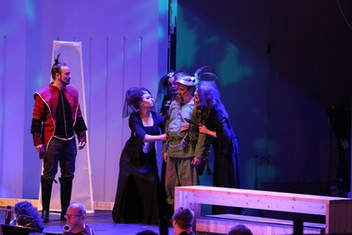First opera with Markku
- Huba Hollókői

- Apr 27, 2020
- 3 min read

Now, due to the corona-crisis, I had time to go through some archives. I found some photos and the (rather favourable) review of our first opera we did together with Markku Pölönen, Zauberflöte by Mozart.
Markku is originally a film and stage director, writer, painter, however, most of all: thinker. And a very emphatic thinker. From the very start, we were able to set our goals together, and the vision of the Magic Flute was getting shape quickly.
We had to face the challenges of Carelia Sali (Carelia Hall) in Joensuu, which are, in fact, quite many. It was built in the 1980's, as a lecture hall/concert hall of Joensuu City Orchestra. It might work well as the biggest lecture hall of the University, but as a concert venue, it has many flows. Thanks to the irregular, "shell" shape, the acoustics are uneven. The balance changes a lot, depending where you sit in the audience. Furthermore, it has extra challenges for any staged productions: the left wall of the stage is an outer wall, which means, there is no way to go round, behind the stage, and there is simply no door on the directors left. Niente. There is a huge, packing door in the back, and two doors on the right side; one slightly hidden, in the back, one in the front, for the audience.
Walls are white, which is a challenge for the lights. Neither cord attic, nor any stage mechanics, of course.
There is a lowered pit for the orchestra, which outlines you can see on these photos, under the piano. It has one, fixed depth, about 2,5 meters, because the pit-entrance door is on the bottom level. That door one can reach via a tunnel under the auditorium. The pit is about 38 m2 in size, which is small even for a Mozartian orchestra. We soon ruled out the use of it, not only because it's small size, but also because thanks to the odd place of it, right under the main acoustic panel above the stage, it amplifies the orchestra too much, and puts the singers behind a "sound curtain"; making almost unsolvable balance problems between singers and orchestra.
Not to mention such small inconveniences, like there was only one room for soloists, one for the orchestra, and one for the full choir...so at the end, all corridors and corners were occupied...
We had to come up with a solution to deal with all these problems. Since there is a lot of travelling in Mozart's opera, and the main theme is the journey of Tamino, it seemed reasonable to build a stage, in the shape of a ring, around the orchestra. The stage was more like a catwalk, about 50 cm high in the front and 1 meter in the back, with a small elevation, and about 70-200 cm wide.

On this photo, where Talvi-Maria Turunen and Juha Eskelinen are singing the Papageno duet, you can see, the front of the catwalk was quite narrow. At least, this was a great place to sing, in front of the orchestra, near to the conductor. This way, we could also use the two stairs of the auditorium, and singers could step on the stage easily coming from the back of the audience. We could have some more space at the sides and the back, for choir bits, and scenes with more singers.
All the stage elements were rather symbolic. A small, elevated platform was the pulpit of Sarastro, in other scene the resting place for Tamino. The temple was symbolized by three, pyramid shaped columns. The rest was achieved by lights.
In order to save rehearsal time, and to deal efficiently with the limited "resources", we decided to make a screen-play for the whole opera. We wanted to make sure, that the walking directions on our "stage ring" are coherent, and the different scenes are easy to identify without much stage sets. We also had to make sure, that singers have enough time to reach their entrances, since some of the doors were bit far from each other.
The costumes were simple, but in my opinion, expressive. Our costume designer, Riitta Pirhonen-Heiskanen worked closely with Markku, and they created a timeless design, with harmonizing colours.
We had a wonderful cast. Energetic, precise, and very reliable. It was a pleasure to work with them, and an uplifting experience. I am very grateful for it.
Matti Turunen – Sarastro, Tero Harjunniemi – Tamino, Juha Kotilainen – Speaker of the temple, Sirkka Lamminen – The Queen of the Night, Henna-Mari Luolamo – Pamina, Juha Eskelinen – Papageno, Talvi-Maaria Turunen – Papagena, Jukka Romu – Monostatos, Timo Turunen ja Sami Ryynänen – Two priests, Anneli Hynninen, Sanna Heikkinen and Maarit Aura – Three ladies, Jarmo Kuittinen ja Janne Piipponen – Two armoured men, Anna Ahonen, Hanna Juuti and Siiri Laine – Three child-spirits
























Comments